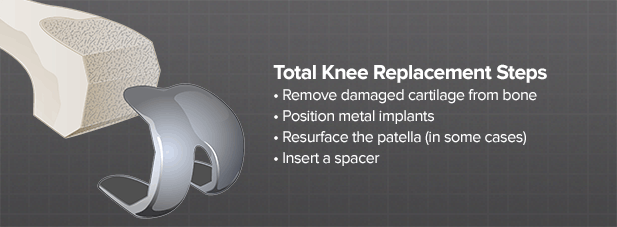
According to the Agency for Healthcare Research and Quality, more than 600,000 knee replacements are performed each year in the United States. In addition, total knee replacements are one of the most successful procedures in all of medicine.1
If non-surgical treatments are no longer enough to allow you to perform your daily activities, your doctor may recommend total knee arthroplasty, or replacement, surgery. During total knee replacements, your surgeon will remove the damaged cartilage and bone and then fit implants to ends of your upper and lower leg bones.
When you undergo a total knee arthroplasty, your surgeon replaces the surface of your femur and tibia bones with metal and plastic, devices. There are many different types of implants. Your surgeon will discuss with you the type of implant that best meets your needs. Your surgeon may opt to use digital templating software to help pre-operatively plan your operation and calculate which implant is best for you.
A total knee replacement consists of three to four basic steps, including preparing the bone, positioning the implant, possibly resurfacing the patella, and insertion of a spacer that acts as a smooth surface for the femoral and tibial implants to glide across.
Once your surgeon has removed the damaged or diseased bone, your knee is ‘fitted’ with the new artificial parts. Your doctor will use trial implants to ensure that the size is correct before cementing or fitting the new metal implant components to the bones where the cuts were made. The metal component in your new artificial joint recreates the bony surfaces of your joint while the plastic or polyethylene component functions as the cartilage taken out during surgery. The whole procedure is designed to help restore alignment and function to your knee.
You may take comfort to know that, according to the American Association of Orthopaedic Surgeons, more than 90% of modern total knee replacements are still functioning 15 years after surgery.2
Total knee replacement is considered when conservative treatments fail to provide adequate pain relief. For many patients with advanced joint disease a total knee replacement offers a realistic chance for long-term pain relief and a return to normal activities.
Understand software-guided knee surgery »
Prepare for the before and after of knee surgery »
Explore digital templating software »
1 Agency for Healthcare Research & Quality (AHRQ)
2 American Association of Orthopaedic Surgeons (AAOS)